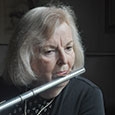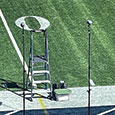Performing chamber music is one of the delights of playing the flute. Whether it is a duo, trio, quartet, or multi-part flute choir compositions, flutists enjoy the camaraderie of making music. By definition, chamber music is art music played one on a part by a small group of musicians.
To Sit or Stand
In paintings we see flutists standing or sitting while playing chamber music. One of the most famous paintings, Flötenkonzert Friedrichs des Grossen in Sanssouci by Adolph Menzel (1815-1905), shows the king playing the flute while standing. His position is excellent with his left foot in front, his arms hung, and his nose aligned with the crease in his left elbow. The king’s teacher, J.J. Quantz, was seated someplace in the room, and C.P.E. Bach accompanied at the harpsichord. This music was intended to be played in a smaller chamber or room in the palace.
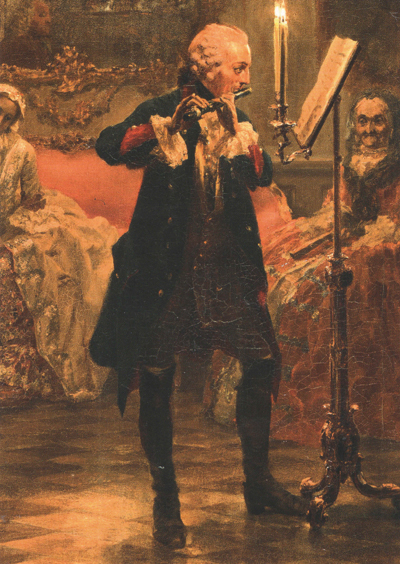
Over time instruments were developed to produce larger sounds, which meant that chamber music performances were no longer just for the wealthy but could take place in concert halls for increasingly more and more people. In an effort to be interesting and better communicate with the audience, performers began standing when performing so they could bring excitement to their performances.
Most flutists agree that standing offers a better breathing setup and permits expression from the whole body. You probably have stood at most lessons. It also offers a position of power, and players look more active as they present the music. Cues are generally easier to communicate when standing.
How to Stand
Oboe and clarinet players find that standing with the feet side by side works well because the instrument is held directly in front. However, as with other instruments that are played to the side (bassoon, horn, trombone, tuba, violin, and viola), flutists should place the left foot in front and the right foot back. This offers the best solution to the asymmetrical setup. In sports such as volleyball and tennis, this left foot in front stance is useful and powerful.
Standing Mat
Suzuki-trained violinists often use a standing mat as beginners. This mat helps them know where to place their feet for effective performance. I adopted this idea for flutists. To make one, you can use one yard of muslin, a yard stick, and a black sharpie. At the top, write the words music stand. This is where the music stand will be placed. Then draw a line 30 inches back, showing where the feet are to be placed. Either trace the flutist’s feet or write the words left and right where you want the feet to be placed. The purpose is to provide a general idea of where the feet are placed comfortably.
Align the center of the body with the line that intersects the right angle. When playing, the lower part of the body is facing 45 degrees to the right. Then turn the head to the left and align the flute with the line that is identified as flute. If a flutist’s aperture is in the center or on the player’s left, the end of the flute should be in front of the flutist’s nose. Hang the arms. The goal is to align the aperture, embouchure hole of the flute, and the crease in the left elbow with the center of the music stand. This mat does not indicate that a student should never move when in this position, but it should be used when the student is staying in the same position.
.jpg)
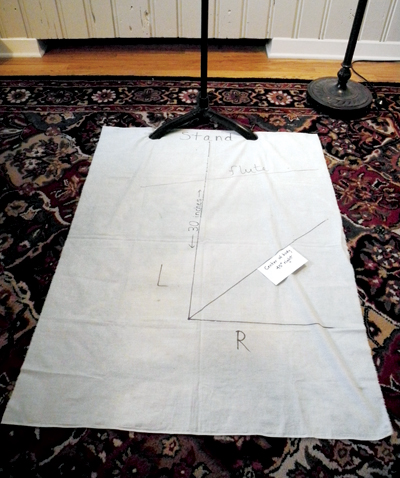
Where to Stand
Each type of ensemble will have its own set of rules to consider when setting up a standing or seating chart. The two most important things to consider are balance and whether the musicians can see each other well for good ensemble playing. When flutists play with string players, the goal is to have the f hole facing out if possible.
Since orchestral audiences are used to having the higher notes on the left and the lower on the right, this works well for chamber ensembles also.
Duos
From the audience’s view, part 1 is on the left and part 2 is on the right. While it is tempting to play from one stand, both performers will be more comfortable and have better projection if two stands are used. Angle the stands slightly so the players will be able to see each other well to communicate cues such as starting, stopping, accelerandos, and ritards. If the players are a violin and a flute, the violin should stand on the left, as viewed from the audience, and the flute should be on the right because of the placement of the violin f holes.

Trios
Generally trios are set up in a letter C. On the left is part 1, in the middle is part 2, and on the right is part 3. However, if the third part is not equal in importance to parts 1 and 2 and is more of an accompaniment, a better placement is to place part 3 in the middle and part 2 on the right.

Quartets
Quartets are set up in an elongated letter C. From left to right, parts 1, 2, 3, 4. Sometimes you see this in reverse, probably because in orchestra the setting for a four flute section would be that way. However, I think most audience members will feel that the top voices are on the wrong side of the stage with the first part on the right.
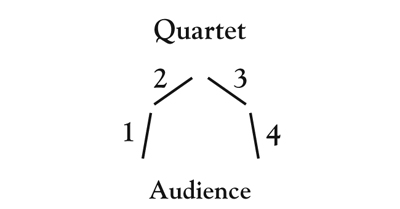
Quintets
A quintet can be set up in the same left to right manner. However, sometimes an alternate setup may work better. Look at the music to determine the importance of the parts. In the Boirsmortier Five Flute Concertos, the fifth part acts as a continuo part, so the setup would be better as 1, 2, 5, 4, 3 (from left to right). This works well because parts 1 and 2 play antiphonally with parts 3 and 4, and this setup offers the audience a clear perspective of the dialogue.
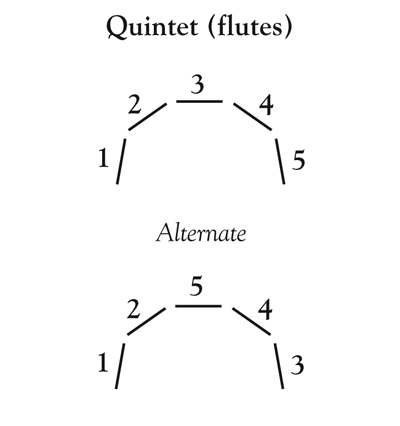
Woodwind quintets may be set up several ways. My preference is to go from left to right, with flute, oboe, horn, bassoon and clarinet. I like this because it mimics how the musicians sit in an orchestra – flute with oboe and clarinet by bassoon. Sometimes the horn player and the bassoon may want to switch places, depending on the music.

Flute Choir
When flute choirs first became popular, the low flutes, because of their design, were quite soft, so directors placed them in the front row so they could be heard. With the advent of new, more powerful designs, the lower flutes can be placed in the back row and still be heard. I prefer having the low flutes in the back row because when tuning we listen from the bottom up. If the low flutes are in the front, the other players are tuning from reflected sound. C flutes should be seated similarly to an orchestra with flute 1 in the place of violin 1, flute 2 in the place of violin 2, flute 3 in the place of the viola section, and flute 4 in the place of the cellos. In the back row from left to right will be the piccolo(s), alto flutes, and bass/contra flutes.
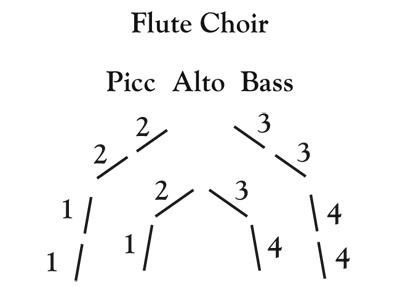
Knowing where to stand and why adds a level of professionalism to performances. In addition, when lower parts are placed where they can be distinctly heard, intonation improves. Be sure stands are close together so musicians have good eye contact and can hear each other well. Often stage hands set the stands incorrectly; never be embarrassed about rearranging them for optimum performance position.

